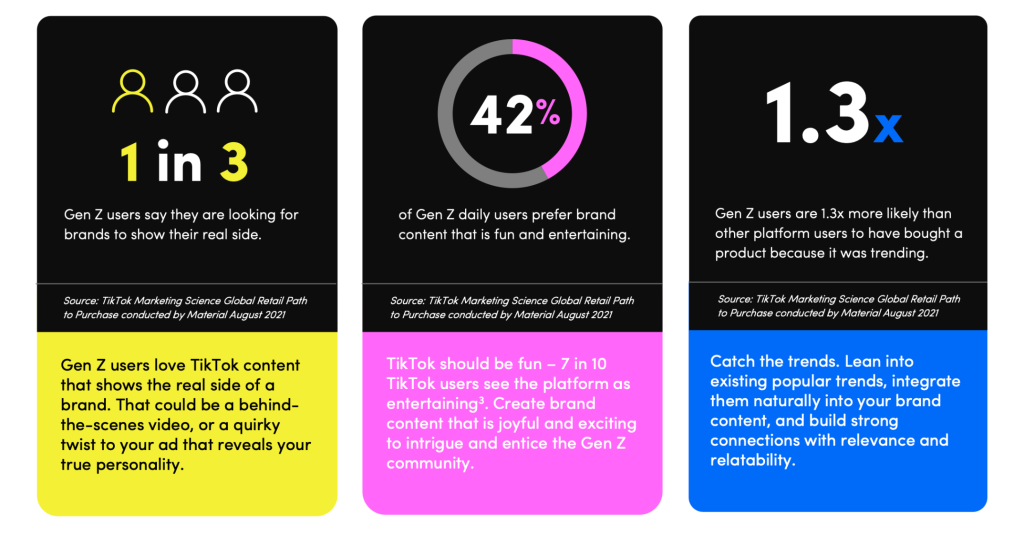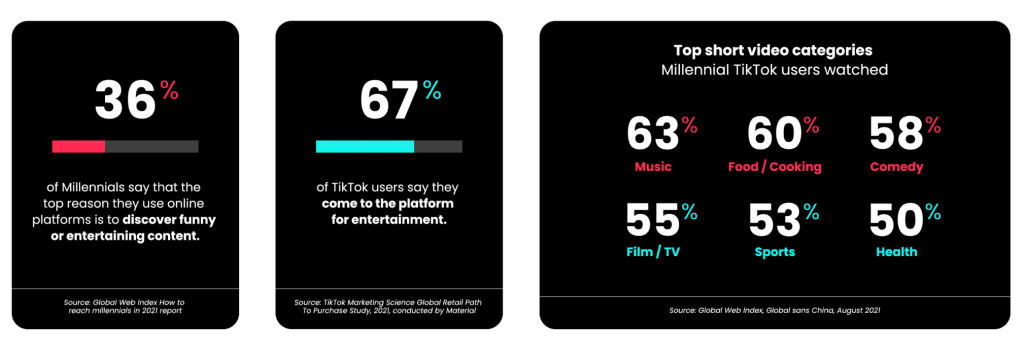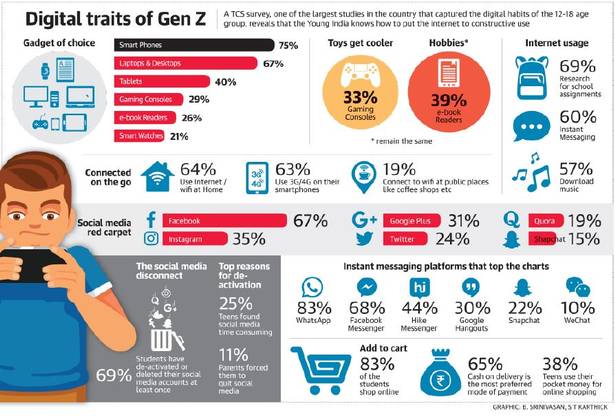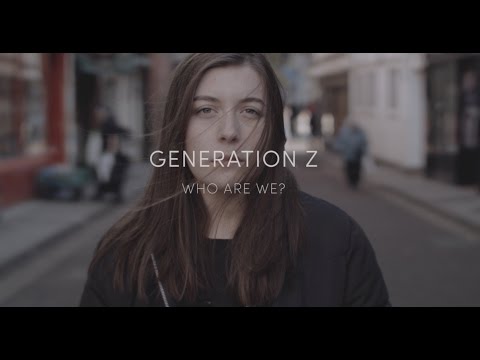Is TikTok replacing Google in search? Yes, according to Google itself
Senior Vice President Prabhakar Raghavan, who runs Google’s Knowledge & Information organisation, mentioned in a conversation at a tech conference earlier this year, that the search behaviour of young people, especially Gen Z and Alpha is changing.
He said this:
In our studies, something like almost 40% of young people when they’re looking for a place for lunch, they don’t go to Google Maps or Search. They go to TikTok or Instagram.
FORTY PERCENT.
TikTok picked up on this change in behaviour faster than Google and is adjusting accordingly.
What’s TikTok’s primary goal?
To keep users on its platform as long as possible.
TikTok and all the other social media platforms are looking for ways to make users’ experiences so fun that they don’t WANT to leave. They are also searching for new ways to cater to users’ every need so they don’t HAVE to leave. Looking for a new exciting place to eat out? Don’t need to search on Google, you can search on TikTok!
TikTok’s latest update confirms its focus on developing its search feature
To support this new behaviour, TikTok recently announced that its latest update allows users to post up to 2,200 characters in a video description. This means that with more text TikTok can better index search results.
With the average user spending almost 2 hours on TikTok as per Sensor Tower and Gen Z spending nearly 3 hours according to eMarketer, it’s a golden opportunity for marketers to get on the app and create content for the relevant keywords.
Here’s another statistic relevant to the amazing influence of TikTok on its users: there are over 24 billion views of #TikTokmademebuyit with users buying all sorts of products ranging from cat brushes to levitating light bulbs.
For some of these products, TikTok was a powerful sales generator after they went viral.
Like Clinique’s Black Honey Lipstick, which launched fifty years ago. Last year it was discovered by Gen Z and went viral on TikTok causing it to sell out in every store, including Clinique. Check out #cliniqueblackhoney, it has over 83 million views.
Another product that blew up on TikTok, also from the makeup vertical, is Maybelline’s Sky High Mascara. Where did it originate? A short analysis shows that it might have begun with this user trying the product on. Her video has 1 million views, the #skyhighmascara has now 711 million views.
Users searching for products and services on TikTok instead of Google coupled with TikTok giving users bigger video descriptions have huge implications for B2C brands. If you are a marketer working with B2C brands, take a closer look at TikTok and ask yourself and your team these questions:
Is our customer base on TikTok?
After seeing our product on TikTok, will they go I gotta have it!
Are there influencers with engaged communities relevant to our product? Should we work with them?
Should we build a community on TikTok yourselves or rely exclusively on influencer-led campaigns?
Before making a decision, here are 2 more insights to provide further guidance:
TikTok Communities
Surprisingly, #comedy (1722 billion views), #makeup (307 billion views) and #fashion (185 billion views) are not the only growing communities.
You should also know about #BookTok, the TikTok community where users share their favourite books. Videos labelled with this hashtag have 79.5 billion global views.
Recently TikTok announced a new feature dedicated to book lovers in this community developed in collaboration with Penguin Random House. “This feature allows users to link their favourite Penguin Random House books within their videos. Clicking the link directs people to a dedicated page with details about the book, including a brief summary, and a collection of other videos that linked the same title,” said TikTok in their announcement.
#momsoftiktok is another community of engaged creators with 144 billion views. Surprising, isn’t it? Gen Z is not the only generation on TikTok, Gen Xers and Millennials are on the app too.
Does your product fall in any of these categories?
If it does, log into TikTok and see what creators in these communities are talking about.
What are TikTok creators looking for?

Gen Z TikTokers are using the app to express their creativity and find inspiration.
They are also more likely than other TikTok generations to discover new brands and products on the platform.
And another insight from TikTok: they love creating tutorial videos about their favourite finds.
What they expect from brands is to be authentic, entertaining (which doesn’t mean doing comedy) and show real people.

Millennial TikTokers go on TikTok to watch entertaining content and content that aligns with their interests.
6 in 10 Millennials on TikTok are parents so they are also watching videos related to parenting (#momsoftiktok, 144 billion views).
Other video categories include music (63%), food/cooking (60%), comedy (58%), film/tv (55%), sports (53%) and health (50%).
Gen Z: 30 consumer behaviour insights
Gen Z refers to the generation born between 1997 to 2012. The oldest members of Gen Z are 25, have recently entered the global workforce and their annual spending power has been estimated at over 140 billion US dollars, as per Business Insider.
If Gen Z is your consumer, share these consumer behaviour insights with your team to help you market your product successfully.
Gen Z: 30 consumer behaviour insights
- They are the mobile-first, digitally native generation;
- 73% of Generation Z consumers are willing to pay 10% more for sustainable products (Bloomberg);
- 53% of Gen Z want brands to offer personalised or customised products (World Advertising Research Centre);
- A brand’s ethics and behaviour concerning environmental and socio-political issues are important decision-making factors for Gen Z (PWC);
- They are more economical and price-sensitive, and spend less generally; 19% of Generation Z are willing to buy on credit, compared to Millennials, where 30% are inclined to do the same (APPTUS);
- They use social media to seek inspiration, research products and connect with their favourite brands (APPTUS);
- 60% of Generation Z in the US use Instagram to discover new brands, products and services (APPTUS);
- Nearly 40% of Gen Z members (born from 1997 to 2012, according to the Pew Research Center) prefer TikTok for online searches (ABC News);
- Compared to older age groups, Gen Z shoppers are less likely to trust companies. Instead, they choose to follow influencers on Instagram and YouTube;
- Generation Z embraces mobile payments like mobile apps and mobile wallets;
- Gen Z is focused on individual expression and identity in their content consumption. They are more likely to advocate for specific causes that they have researched through online media platforms. And they are more open to discussion with others of differing values and belief systems (Content Science);
- YouTube is the most used platform overall with 88% of respondents using it since 2020 – rising to 93% in Gen Z adults (aged 18 – 29) (Exchange Wire);
- 62% of Gen Z teens use Instagram, 59% use Snapchat, 67% use TikTok (Pew Research Institute);
- Gen Z customers value one thing above all else: flexibility. This is why offering BNPL options, like PayPal’s Pay in 4 solutions, is crucial for attracting the Gen Z market (The Financial Brand);
- Gen Z is now spending 43 minutes more per on online shopping than they did before the COVID-19 outbreak (5WPR);
- Gen Z trusts influencers the most, with 11% using them as their trusted source for product recommendations – compared to 7% in millennials and 3% and lower in 40+ consumers (Survey Monkey);
- 5 things Gen Z will spend money on Electronics and Technology, Discounted Goods, Health and Wellness, Small Businesses, Education (5WPR);
- Education: Gen Z is also likely to invest in courses or educational programs that will advance their future earnings (Hubspot);
- LinkedIn Learning: Gen Z learners watched 50% more hours of educational content on LinkedIn (LinkedIn);
- Gen Z spends 12% more of their time on LinkedIn Learning building their hard skills when compared to the average learner (LinkedIn);
- 69% of Gen Zers say they want to learn about a topic they are personally interested in (LinkedIn);
- Gen Z strongly prefers learning on mobile devices (LinkedIn);
- Gen Z is almost twice as likely as millennials to make a purchase based on a recommendation of an influencer. Brands should look to activate influencers with highly engaged followers that share a natural affinity for their products or services (Rolling Stone);
- Gen Z buys from Gen Z. Whether you’re using an influencer or an agency, make sure the authentic Gen Z voice comes through loud and clear. Find people who speak — not mimic — the language (Rolling Stone);
- Nearly 1 in 5 Gen Z’ers want to run their own business, and the vast majority of them would like to turn pet hobbies into full-time careers (WGU EDU);
- Today’s online influencers don’t have to demonstrate proven expertise in an area or a high-profile endorsement deal. Instead, when it comes to shaping the views of Gen Z consumers, it’s enough for today’s influencers to have an online following around a specific topic, lifestyle, experience, product, service, or outcome;
- Gen Z prefers real content over branded promotions. There is a growing trend on this platform called ‘TikTok made me buy it’ with almost 24 billion views (World Finance);
- Gen Z’s purchase decisions have not been shaped by advertisements or brand promotions, but ‘normal people’ and some influencers talking about the products and the companies making the product;
- Generation Z adults—individuals who are between 18 and 25 years old—proved to be more financially sophisticated than any previous generation was at their age (Investopedia);
- About a quarter of Gen Zers hold cryptocurrencies and stocks, and one in 10 own NFTs (Investopedia).
How to speak marketing for the Generation Z?
If you still haven’t figured out the Millennials yet is high time you do it, because there is a new generation coming your way: one that is even younger and closer to technology then the Millennials. Unlike Millennials who are stereotyped as self-involved and demanding, the New York Times calls Gen Z “conscientious, hard-working and mindful of the future.”
According to yourcareerintel.com, more than a quarter of America’s population belongs to Gen Z, giving it a slight edge in size over Baby Boomers (23.6%) and Millennials (24.5%), reports US Consultancy Sparks and Honey. While much of this generation is still in their teens, they’re eager to start working. Parents of Gen Z are encouraging their children to find jobs early and independently, without their help. “Gen Zers are highly driven to achieve and more than half of all high school students are eager to gain independent job experience. College students are loading up on internships and summer positions to hone in on their dream job post-college,” added yourcareerintel.com.

source: The Hindu
Who are they?
According to Wikipedia, Generation Z or Gen Z (also known as iGeneration or iGen, Post-Millennials, or Homeland Generation) is the demographic cohort after Millennials. Currently, there are numerous additional competing names used in connection with them in the media, demographers and researchers typically use the mid-1990s to mid-2000s as starting birth years. At the present time, there is little consensus regarding ending birth years. Moreover, most of Generation Z have used the Internet since a young age, and they are generally comfortable with technology and with interacting on social media.
“Gen Z lives in a world of continuous updates. Gen Z processes information faster than other generations thanks to apps like Snapchat and Vine. Thus their attention spans might be significantly lower than Millennials. Gen Z can quickly and efficiently shift between work and play, with multiple distractions going on in the background…working on multiple tasks at once. Gen Z are entrepreneurial and know the true value of independence, and knowledge is no exception here. If a Gen Z’er knows they are capable of learning something themselves, or through a more efficient, non-traditional route, you can bet they’ll take the opportunity,” wrote Huffington Post.
Meagan Johnson, a generational expert, speaker and author of From Boomers to Linksters: Managing the Friction Between Generations at Work, defines anyone born after 2002 (and therefore post-millennial) as the Linkster generation. “We chose the term Linkster Generation because it is the first generation to be linked into technology from day one. Millennials brought technology into the cultural focus and have pushed other generations to use technology. However, there are Millennials that can remember using dial up or even a life before social media,” Johnson told The Independent.
Therefore, the Linkster population – estimated to make up 18 per cent of the world’s population – grew up with social media, smart phones and apps. According to Johnson’s intervention for The Independent, the Linkster Generation may never hold a textbook, read everything from a tablet and never learn cursive writing and it may never write a check or walk into a traditional bank.
When it comes to their consumption on social media, Business Insider quoted the data gathered by a study conducted by the research firm 747 insights, in partnership with consumer research platform Collaborata, showing that only 49% of Gen Zers agree with the statement “Social media is an important part of my life” — a truth 61% of Millennials admit to. However, nearly 60% of both generations are concerned that social media is too public and that their posts could come back to haunt them. For Gen Z, this concern has changed its behavior: Members favor Snapchat in part because of the strict control over who can see their posts.
More on the study’s results you can read here.
Moreover, in November, a Piper Jaffray survey found 47% of teens consider Snapchat their favorite social media platform, up from 35% the year before. Instagram was the preferred platform for 24% of teens, the same number as one year earlier. Meanwhile, only 9% of teens chose Facebook — a decline of 4% from 2016. And that just after in September, market research firm eMarketer estimated that the number of Facebook users between the ages of 12 and 17 would be to fall 3.4% to 14.5 million people by the end of the year.
Gen Z is pragmatic and realistic, but they also believe it is possible to achieve their “dream job” and build a career doing what they love. Nearly a third of Gen Z (32%) said their greatest aspiration is to be at their dream job 10 years from now, according to Fortune. They’re realistic about how tough it may be to find this job, however. An equal amount (32%) say that finding a job is their top concern.
All of these data and more must be very well looked at and perceive by marketers in order to make sure that their campaigns will fit like a glove the wanted target.

